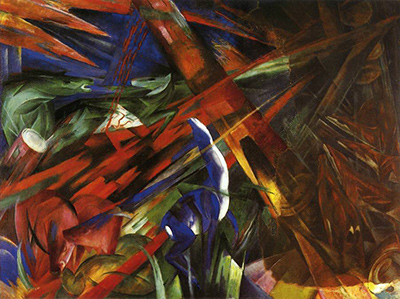Animal Destinies by Franz Marc is notable for the way it challenges the style in which the painter had previously depicted animals
Where Marc had often tended to showcase his animal subjects in wistful, or blatantly pastoral settings, Animal Destines places them in a nearly abstract, angular tableau that strongly suggests suffering and turmoil.
The presence of fire in the painting's forest scene, and the exposed vasculature of the green deer lend a sense of urgent cause and effect.
The fearful contortion of the animal forms is in opposition to the strong unidirectional paths of the destructive forces consuming the scene. A second green animal, likely a horse, can be seen to fearfully bray in the chaos.
The painting was completed in 1913, and is wonderfully illustrative of the Der Blaue Reiter style Marc co-created with fellow impressionist Wassily Kandinsky. Shortly after Marc's death in 1916, Animal Destinies was damaged in a fire.
A third of the painting was destroyed and subsequently restored by the painter Paul Klee, a close friend of Marc's. Working from photographs of the original painting, Klee was able to recreate the damaged portion, though with the puzzling variation of using a brown tint.
This choice has never been fully understood by art historians. Klee is also noted for having suggested an alternate title for the painting, “The trees show their rings, the animals their veins”.
It is thought that he arrived at this title based upon both the tree rings and aforementioned venous structures evident in the piece. Klee's suggestion aside, the painting is believed to have an official subtitle, “And all being is flaming suffering”, which is written on the back of the canvas, likely by Franz Narc himself.




